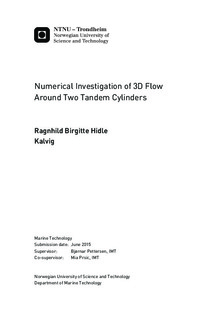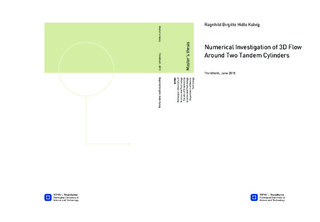| dc.contributor.advisor | Pettersen, Bjørnar | |
| dc.contributor.advisor | Prsic, Mia | |
| dc.contributor.author | Kalvig, Ragnhild Birgitte Hidle | |
| dc.date.accessioned | 2015-10-05T15:03:30Z | |
| dc.date.available | 2015-10-05T15:03:30Z | |
| dc.date.created | 2015-06-05 | |
| dc.date.issued | 2015 | |
| dc.identifier | ntnudaim:13904 | |
| dc.identifier.uri | http://hdl.handle.net/11250/2350671 | |
| dc.description.abstract | Circular cylinders in tandem arrangement are used in many marine applications like dual pipelines and dual risers. Turbulent flow in 3D around two tandem cylinders is simulated numerically using Large Eddy Simulation (LES) with a Smagorinsky subgrid scale model. The Reynolds number based on the cylinder diameter of 1 meter and free stream velocity of $U=1.31$ m/s is 13100, which is in the subcritical flow regime. The center-to-center spacing between the cylinders is $S/D=5$. The software used for the numerical simulation is the open source code OpenFOAM.
The physics of the flow around the cylinders has been investigated by studying velocity- and pressure fields, especially in the gap region between the two cylinders. The results are presented as following: Vorticity distribution in the gap showing vortex formation and impingement onto the downstream cylinder. Velocity distributions in the wake and gap showing wake flow. Mean and Root Mean Square (RMS) pressure distributions over the cylinder surfaces. Drag- and lift coefficients for the two cylinders. Strouhal number at different locations in the domain and surface streamlines showing separation.
The flow picture for this spacing and Reynolds number proved to be jump flow, where vortices are formed and shed behind the upstream cylinder, travel over the gap and impinge the downstream cylinder. This causes large pressure fluctations and forces on the downstream cylinder. This was reflected in the pressure distributions and force coefficients. The Strouhal number was the same behind both cylinders which indicates synchronized shedding of vortices. The downstream cylinder sees a chaotic inflow due to vortices shed from upstream cylinder. This was reflected in the velocity streamlines. There was indications that the results for the downstream cylinder did not converge for the simulation duration in this work. In general the LES turbulence model gave good results that were in agreement with previous work. | |
| dc.language | eng | |
| dc.publisher | NTNU | |
| dc.subject | Marin teknikk, Marin undervannsteknikk | |
| dc.title | Numerical Investigation of 3D Flow Around Two Tandem Cylinders | |
| dc.type | Master thesis | |
| dc.source.pagenumber | 102 | |

